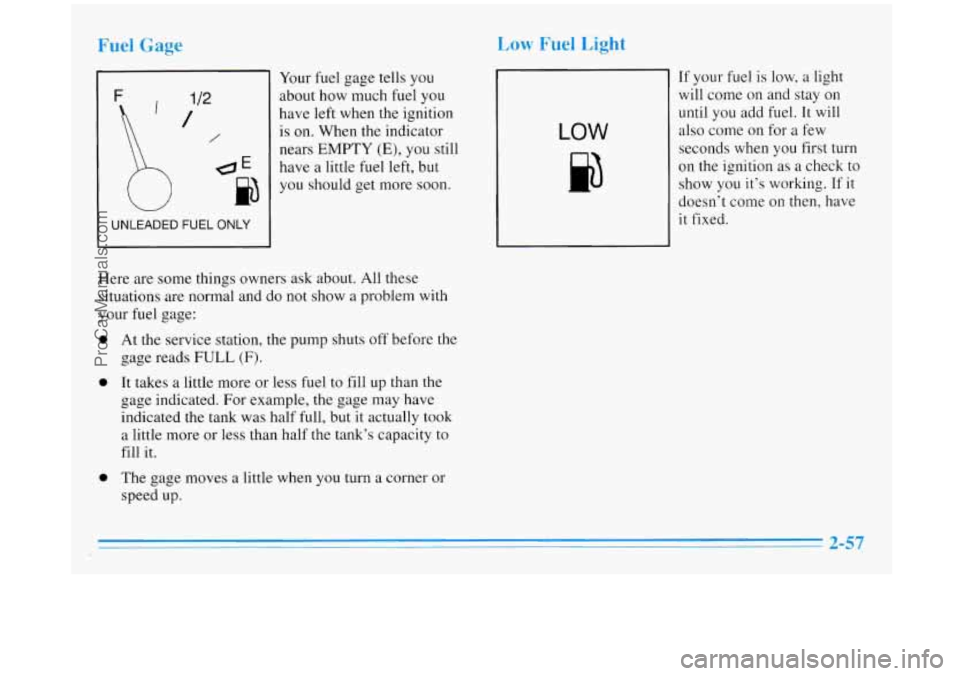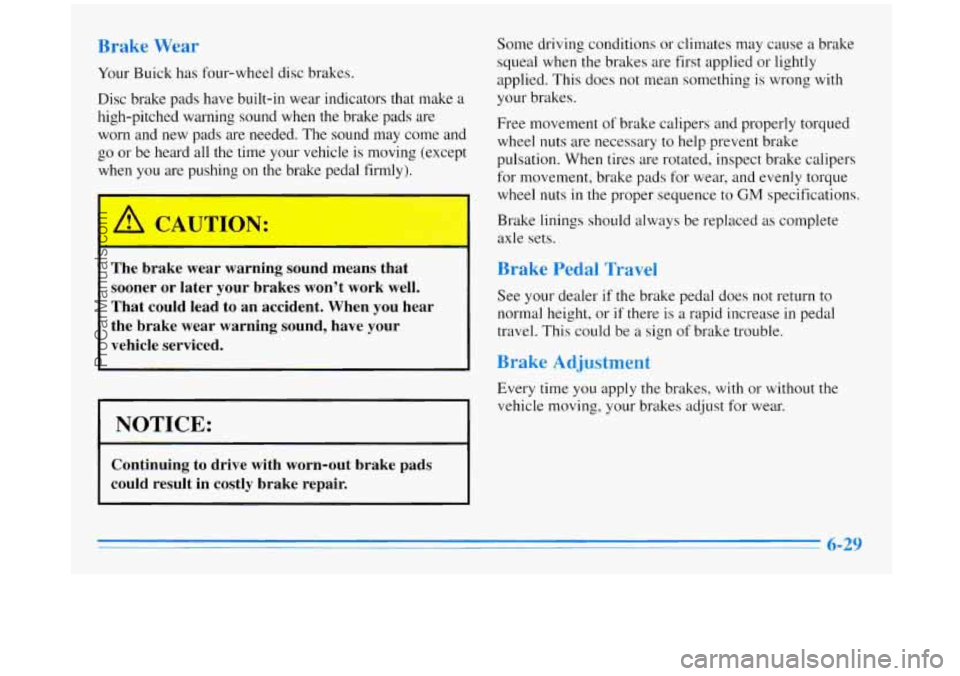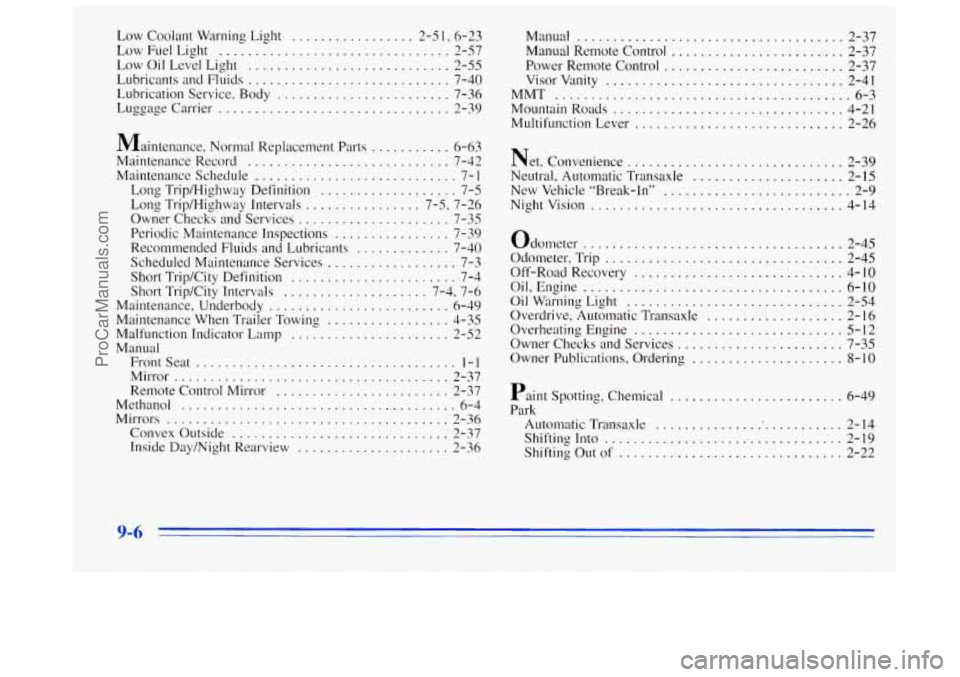1996 BUICK REGAL service indicator
[x] Cancel search: service indicatorPage 76 of 356

A E
C
With the ignition key in the ignition switch, you can turn
the switch to five positions.
ACC (A): This position lets you use the radio and
windshield wipers when the engine is
off. To use
ACC (Accessory), push in the key and turn
it toward
you. Your steering wheel will stay locked.
LOCK (B): Before you put the key into the ignition
switch, the switch is in
LOCK. It’s also the only position
in which you can remove your key. This position locks your
ignition, steering wheel and transaxle. It’s
a
theft-deterrent feature.
OFF (C): This position lets you turn off the engine but
still turn the steering wheel. It doesn’t lock the steering
wheel like LOCK. Use OFF
if you must have your
vehicle pushed or towed.
RUN (D): This position is where the key returns after
you start your vehicle. With the engine
off, you can use
RUN to display some of your warning and indicator lights.
START (E): This position starts your engine.
A warning chime will sound if you open the driver’s
door when the ignition is
in OFF, LOCK or ACC ,and
the key is in the ignition.
- .. - _- -
NOTICE:
If your key seems stuck in LOCK and you can’t
turn it, be sure
it is all the way in. If it is, then
turn the steering wheel left and right while you
turn the key hard. But turn the key only with
your hand. Using
a tool to force it could break
the key or the ignition switch.
If none of this
works, then your vehicle needs service.
ProCarManuals.com
Page 118 of 356

Malfunction Indicator Lamp
(Service Engine Soon Light)
SERV. ENGINE
SOON
Your Buick is equipped
with a computer which
monitors operation
of the
fuel, ignition and emission
control systems.
This system is called
OBD I1 (On-Board
Diagnostics-Second Generation) and is intended to
assure that emissions are at acceptable levels for the life
of
the vehicle, helping to produce a cleaner
environment. (In Canada,
OBD I1 is replaced by
Enhanced Diagnostics.) The SERV. ENGINE
SOON
light comes on to indicate that there is a problem and
service is required. Malfunctions often will be indicated
by the system before any problem is apparent, which
may prevent more serious damage to your vehicle. This
system
is also designed to assist your service technician
in correctly diagnosing any malfunction.
1 NOTICE:
If you keep driving your vehicle with this light
on, after a while, your emission controls may not
work as well, your fuel economy may not be as
good and your engine may not run as smoothly.
This could lead to costly repairs that may not be
covered by your warranty.
This light should come on, as a check to show you it is
working, when the ignition is on and the engine is
not
running. If the light doesn’t come on, have it repaired.
This light
will also come on during a malfunction in one
or two ways:
Light Flashing -- A misfire condition has been
detected.
A misfire increases vehicle emissions and
may damage the emission control system on your
vehicle. Dealer or qualified service center diagnosis
and service is required.
Light On Steady -- An emission control system
malfunction has been detected on your vehicle.
Dealer or qualified service center diagnosis and
service may be required.
ProCarManuals.com
Page 123 of 356

Fuel Gage
F
L
UNLEADED FUEL ONL’
1
Your fuel gage tells you
about how much fuel you
have
left when the ignition
is on. When the indicator
- nears EMPTY (E), you still
1 have a little fuel left, but
b
you should get more soon.
Here are some things owners ask about. All these
situations are normal and do not show a problem with
your
fuel gage:
0
0
0
At the service station, the pump shuts off before the
gage reads
FULL (F).
It takes a little more or less fuel to fill up than the
gage indicated. For example, the gage may have
indicated the tank was half full, but it actually took
a little more or less than half the tank’s capacity to
fill it.
The gage moves a little when
you turn a corner or
speed up.
Low Fuel Light
LOW
If your fuel is low, a light
will come on and stay on
until you add fuel. It will
also come on for
a few
seconds when
you first turn
on the ignition as a check to
show you it’s working. If it
doesn’t come on then, have
it fixed.
ProCarManuals.com
Page 225 of 356

Fuel
Use regular unleaded gasoline rated at 87 octane or higher.
At a minimum, it should meet specifications ASTM
D4814
in the United States and CGSB 3.5-M93 in Canada.
Improved gasoline specifications have been developed by
the American Automobile Manufacturers Association
(AAMA) for better vehicle performance and engine
protection. Gasolines meeting the
AAMA specification
could provide improved driveability and emission control
system protection compared to other gasolines.
Be sure
the posted octane is at least 87. If the octane is
less than
87, you may get a heavy knocking noise when
you drive. If it’s bad enough,
it can damage your engine.
If you’re using fuel rated at
87 octane or higher and you
still hear heavy knocking, your engine needs service.
But don’t worry
if you hear a little pinging noise when
you’re accelerating or driving up a hill. That’s normal,
and you don’t
have to buy a higher octane fuel to get rid
of pinging. It’s the heavy, constant knock that means
you have a problem. If
your vehicle is certified to meet California Emission
Standards (indicated
on the underhood tune-up label), it
is designed to operate on fuels that meet California specifications. If such fuels are not available in states
adopting California emissions standards, your vehicle will
operate satisfactorily on fuels meeting federal specifications, but emission control system pexformance
may be affected. The malfunction indicator lamp on your
instrument panel may turn on and/or your vehicle may
fail
a smog-check test. If this occurs, return to your authorized
Buick dealer for diagnosis to determine the cause of
failure. In the event
it is determined that the cause of the
condition is
the type of fuels used, repairs may not be
covered by your warranty.
In Canada, some gasolines contain an octane enhancing
additive called MMT. If you use such fuels, your
emission control system performance may deteriorate
and the malfunction indicator lamp on your instrument
panel may turn on.
If this happens, return to your
authorized Buick dealer for service.
6-3
ProCarManuals.com
Page 251 of 356

Brake Wear
Your Buick has four-wheel disc brakes.
Disc brake pads have built-in wear indicators that make
a
high-pitched warning sound when the brake pads are
worn and new pads are needed. The sound may come and
go or be heard all the time your vehicle is moving (except
when you are pushing on the brake pedal firmly).
A CAUTION:
I
The brake wear warning so Id means that
sooner or later your brakes won’t work well.
That could lead to an accident. When you hear the brake wear warning sound, have your
vehicle serviced.
I NOTICE:
Continuing to drive with worn-out brake pads
could result in costly brake repair.
Some driving conditions or climates may cause a brake
squeal when the brakes are first applied or lightly
applied. This does not mean something is wrong with
your brakes.
Free movement of brake calipers and properly torqued
wheel nuts are necessary to help prevent brake
pulsation. When tires are rotated, inspect brake calipers
for movement, brake pads for wear,
and evenly torque
wheel nuts
in the proper sequence to GM specifications.
Brake linings should always be replaced
as complete
axle sets.
Brake Pedal Travel
See your dealer if the brake pedal does not return to
normal height, or
if there is a rapid increase in pedal
travel. This could be
a sign of brake trouble.
Brake Adjustment
Every time you apply the brakes, with or without the
vehicle moving, your brakes adjust for wear.
ProCarManuals.com
Page 350 of 356

Low Coolant Warning Light ................. 2-5 1. 6.23
LowFuelLight
................................ 2- 57
LowOilLevelLight
............................ 2-55
Lubricants and Fluids
............................ 7-40
Lubrication Service. Body
........................ 7-36
Luggagecarrier
................................ 2-39
Maintenance. Normal Replacement Parts ........... 6-63
Maintenance Record
............................ 7-42
Maintenance Schedule
............................ 7- 1
Long Trip/Highway Definition ................... 7-5
Long Trip/Highway Intervals
................ 7-5. 7-26
Owner Checks and Services
..................... 7-35
Periodic Maintenance Inspections
................ 7-39
Recommended Fluids and Lubricants
............. 7-40
Scheduled Maintenance Services
.................. 7-3
Short Trip/City Definition
....................... 7-4
Short Trip/City Intervals
.................... 7-4. 7-6
Maintenance. Underbody
......................... 6-49
Maintenance When Trailer Towing
................. 4-35
Malfunction Indicator Lamp
...................... 2-52
Manual FrontSeat
.................................... 1-1
Mirror ...................................... 2-37
Remote Control Mirror
........................ 2-37
Methanol
...................................... 6-4
Mirrors
....................................... 2-36
Convex Outside
.............................. 2-37
Inside Daymight Rearview
..................... 2-36 Manual
..................................... 2-37
Manual Remote Control
........................ 2-37
Power Remote Control
......................... 2-37
Visor Vanity
................................. 2-41
MMT
......................................... 6-3
Mountain Roads
................................ 4-21
Multifunction Lever
............................. 2-26
Net. Convenience
.............................. 2-39
Neutral. Automatic Transaxle
..................... 2-15
New Vehicle “Break-In”
.......................... 2-9
Nightvision
................................... 4-14
Odometer
.................................... 2-45
Odometer. Trip
................................. 2-45
Off-Road Recovery
............................. 4-10
Oil. Engine
.................................... 6-10
Oil Warning Light .............................. 2-54
Overdrive. Automatic Transaxle
................... 2-16
Overheating Engine
............................. 5-12
Owner Checks and Services ....................... 7-35
Owner Publications. Ordering
..................... 8- IO
Paint Spotting. Chemical ......................... 6-49
Park Automatic Transaxle
.......................... 2-14
Shifting
Into ................................. 2-19
Shifting Out of
............................... 2-22
9-6
.
ProCarManuals.com
Page 354 of 356

Trailer Brakes
..................................... 4-32
Driving
on Grades ............................ 4-34
Driving with
................................. 4-33
Hitches
..................................... 4-32
Maintenance When Towing
..................... 4-35
Safety Chains
................................ 4-32
Tongueweight
............................... 4-31
Total Weight on Tires
.......................... 4-32
Towing
...................................... 4-29
Turnsignals
................................. 4-34
Weight
..................................... 4-30
Transaxle Fluid, Automatic
....................... 6- 17
Transmitters, Remote Keyless Entry ................. 2-4
Transportation, Courtesy
.......................... 8-5
Trunk
......................................... 2-6
Lock
........................................ 2-7
Release, Remote
............................... 2-7
TTYUsers
..................................... 8-3
Turn Signal and Lane Change Indicator
............. 2-26
Turn Signal On Chime
........................... 2-27
Turn Signal/Multifunction Lever
................... 2-26
Turn Signals When Towing a Trailer
................ 4-34
Two-way Manual Seat
........................... 1 - 1
Underbody Flushing Service ................... 7-38
Underbody Maintenance
......................... 6-49
Vehicle
. Parking on Hills .............................. 4-35
Trip Odometer
................................. 2-45
Control
...................................... 4-5
Damage Warnings .............................. ix
Dimensions ................................. 6-62
Identification Number
......................... 6-51
Loading .................................... 4-27
Storage
..................................... 6-30
Ventilation System
............................... 3-4
Visor Vanity Mirrors
............................ 2-41
Visors. Sun
.................................... 2-40
warning Devices
............................... 5-2
Warning Lights. Gages and Indicators ............... 2-46
Washer Fluid. Windshield
........................ 6-26
Washing Your Vehicle
........................... 6-47
Weatherstrips
.................................. 6-46
Wheel
Alignment
.................................. 6-40
Nut Torque
............................. 5-29. 6-61
Replacement
................................. 6-40
WindowLock
.................................. 2-25
Windows
..................................... 2-24
Auto-Down
................................. 2-25
Power
...................................... 2-24
Windshield Washer
............................. 2-28
Fluid
.................................. 2-28. 6-26
Fluid Level Check
............................ 7-35
Windshield Wiper
.............................. 2-27
Blade Replacement
........................... 6-34
Fuses
...................................... 6-52
Wiring. Headlamp
.............................. 6-52
WreckerTowing
................................. 5-7
Winter Driving
................................. 4-23
ProCarManuals.com